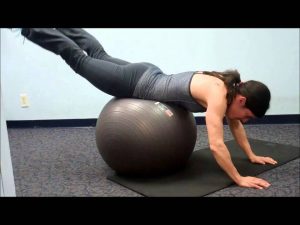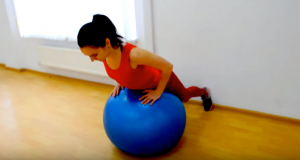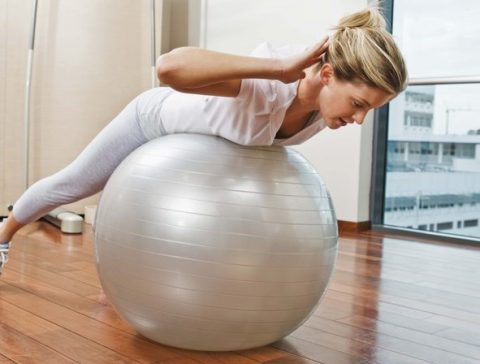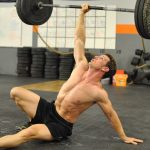One of the best preparatory exercises in hyperextension on the fit ball. All exercises in sports can be divided into basic, which develops physical strength, and auxiliary. The latter is characterized by the fact that they are working on a specific muscle group, or better yet, helping to prepare for more serious workouts.
Is it worth it?
Despite its preparatory function, it is a rather difficult exercise. And many mistakenly start to do it, not having mastered techniques properly, or having incompatible problems with health. We will try to understand whether it is worth doing hyperextensions on the fit ball, with what intensity and before what exercises.
Benefit
The most important benefit from the reverse hyperextension on the fit ball is the development of the muscles of the lumbar spine. And this means that this exercise:
- helps reduce the risk of injury
- restores the natural position of the spine;
- allows you to get rid of chronic poor posture;
- develops a tight core;
- doesn’t need a safety belt.
Naturally, this is not an absolute guarantee of the absence of injuries, but at the same time, hyperextension with the correct and competent technique of performance on the fit ball, develops not only the muscle fibers themselves, preparing them for a serious load, but also stretches the spine, which reduces the risk of spasms during heavy exercise.

Contraindications
Despite the fact that this exercise is intended to strengthen the spine, it has a number of significant contraindications:
- categorically it is forbidden to perform hyperextension with weights
- You cannot perform the exercise in the presence of a vertebral hernia;
- It is not recommended to work on the fit ball if you have micro-dislocations of the lumbar region;
- with any injuries of the abdominal cavity.
But the most important thing is that you can not do this exercise if you have had back surgery. In principle, curving of the spine for a long time is generally not recommended to be used with weights, including any types of traction and extension.
Lining
The advantage of the benefit from hyperextension with the correct technique of implementation is undeniable, and almost completely outweighs the potential harm. Even if you have small problems with the spine, then hyperextension will help to recover from injuries or regain flexibility after vertebrae operations. The most important thing is to observe the perfect technique and not be too zealous with speed.
How to do a hyperextension on a fit ball?
Hyperextension on a fit ball is a fairly simple exercise, the technique is as follows. How to properly perform to prevent typical mistakes of newcomers:
- First, pick up the fit ball in accordance with your height.
- Lean on the fit ball in the middle of the body, so that the muscles of the abdomen are tight.
- In this position, put your hands behind your head. Lay them lightly on the back of the neck, in the area of the shoulder blades;
- Gently bend over at a slow pace, trying to get the head of the floor.
- The body must be completely rounded (this is the essence of the exercise).
- After that, do a few springing movements.
- After this, begin the rounding of the spine, trying not to lift your legs off the floor.
- At the top point of the movement, the elbows should turn out.
What are the main mistakes novices make when performing any hyperextension?
- Breathe. Exhalation is done on a return, not in the first phase of the movement.
- They lower their straight back. In this case, the load on the lumbar remains fixed, which can lead to back problems.
- Performing the exercise at a jerky pace, which can lead to jamming of vertebral discs.
- Performing an exercise with too much weight.

What muscles work?
Despite the fact that hyperextension is considered an isolating exercise that involves only the muscles of the lumbar region. Using a fitness ball adds additional strength to other groups.
| Muscular group | Load type | Movement phase |
| Muscles of the lumbar region | Basic | climb |
| Muscle extensors of the spine | Basic | Climb |
| Rhomboid muscles | Secondary | Climb |
| Abdominal muscles | Secondary | Descent |
| Greater Gluteal | Basic | Descent |
| Hamstrings | Basic | Descent |
It is important to understand that a significant load from the muscles of the spine goes to the muscles of the legs, because of the change in the angle of motion. So, as on the classical machine for hyperextension, the main load falls on the lumbar region, and the muscles of the spine can be pinched, slightly changing its position on the ball. In this case, their extension function will be occupied by the muscles of the abdomen and the lifting will be carried out solely by the muscles of the legs.
What if I don’t have a fit ball?
Of course, fit balls are not in every gym. And this means that for many, hyperextensions on the fit ball become a luxury. But this is not a reason to refuse to train the waist and hip muscles.
In the first place, any hyperextension can be replaced by:
- work on the machine with bending of the legs
- deadlifts
- squats
So – one isolating exercise is replaced by two basic exercises, and one using a machine. It is important to coordinate the load. For example, the deadlift for the waist is performed with many repetitions, but with extremely small weights (20-30 kg). The same applies to squats. But there are other exercises that can completely replace the fit ball in the gym.
 How does the hyperextension affect the muscles
How does the hyperextension affect the muscles
Exercise number 1 – classical hyperextension on the machine
Strangely enough, the classic is, in many ways, even more, effective than the version on the fit ball. It has a simpler technique, and most importantly it is much less traumatic, which makes it indispensable in many beginner programs in the gym.
Exercise number 2 – imitation
This requires a partner. The main advantage of this exercise is the ability to perform it naturally, without resorting to any special tricks.
How to do it?
- First, you need to lay face down with most of your body hanging over the edge.
- For greater stability, it is better to use the support of a partner who will hold down your legs.
- The movement is completely identical to the classical hyperextension. But it is better to perform it at a slower rate, in order to alleviate the possibility of falling off.
Exercise # 3 – the somersault
No matter how strange it may seem, the usual somersault, which everyone is used to doing from school, perfectly develops all the same muscle groups. At the same time, it allows, due to the efforts of the hands, to regulate the load. Ideally, the athlete touches the nape of the head and supports himself with his hands. In this case, not only the muscles of the lumbar region actively develop, but serious stretching of the back.
Variations on the topic of hyperextension. This can include both diagonal hyperextension and reverse hyperextension. In mechanics, they practically do not differ from the classics, only the accentuation of the load changes, which confuses many beginners. Perform a variety of exercises in the recovery period after stretching.
The result
Hyperextension on the fit ball – this is primarily an exercise not to enhance athletic performance, but to maintain the spine in tone. It can be performed both for men and women, and most importantly – it is absolutely safe. So, even in the presence of errors in technology, the risk of injury is small. Even the doctors talk about the benefits of back bends, it is not for nothing that it’s used, not only in sports training complexes, but also in physiotherapy courses, and even with lordosis type curvatures, hyperextension is prescribed as an exercise that stabilizes the muscular core, and can restore the normal position of the dorsal vertebrae










